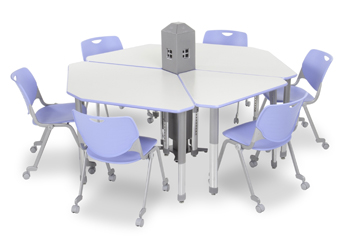Giving Students Power to Succeed
 PLANO, Texas — As collaborative learning has become an increasingly popular design concept for schools, technology has been on the forefront of the model.
PLANO, Texas — As collaborative learning has become an increasingly popular design concept for schools, technology has been on the forefront of the model.
Technology has integrated its way into our lives and has not toned down its approach since burrowing into schools and replacing textbooks with digital readers and iPads. It is safe to say that technology is here to stay and is only continuing to expand its presence in our everyday lives. Schools have been able to witness this firsthand, with the latest design strategies and state-of-the-art equipment now incorporated in classrooms. A majority of students now come in contact with keyboards more than pencils in any given school day.
Plano, Texas-based Smith System manufactures furniture equipment for education environments and saw the need to expand upon its collection to incorporate technology into its designs.
The company has since developed the I~O Post, which has been on the market for just over a year. The product helps students power up their devices without wasting valuable class time. The product is also used in libraries where students can work together on projects.
“We’ve seen a big shift in the way students are learning,” said Charlie Risdall, CEO of Smith System.
The I~O Post has eight power outlets and eight network/phone jacks that can be supplied from a source on the floor or the ceiling through a six-foot cable. The power and data ports encircle the post at seating height, which enable students to position classroom or library furniture around the source for collaboration, and eliminates access restrictions, according to Smith Systems.
As student collaboration has become more of a standard, design has also shifted to incorporate the needs of the students. As Risdall and his company began designing furniture to fit the new educational paradigm, he noticed there was not enough power in the space to accommodate the students and their technological needs.
“We started to see that there weren’t enough outlets in the rooms. Even if the rooms were only 10 to 15 years old, they didn’t have power coming out of the floors and there wasn’t any way to get power to the spaces where the students needed it for their laptops, iPads and whatever other devices the students are using,” explained Risdall.
Risdall designed the I~O Post to answer the power needs for students working collaboratively in libraries, classrooms and/or social space.
“We devised the I~O Post as a power solution for these collaborative spaces. We came out with it a little over a year ago and it has taken off really well since,” Risdall said.
The I~O Post can be used in a multitude of educational environments, but Risdall has seen the product take off the most in schools that are redesigning their library space to accommodate 21st century learning concepts.
“The areas where we’re seeing the most impact are common areas and library spaces in high schools and in some middle schools. Certainly the colleges are doing the same exact thing, where they are converting their library spaces into more collaborative spaces and more comfortable areas for students to sit around and learn together — and they all need power,” Risdall said.
The units are located in close proximity to desks or collaborative learning spaces so students can work on their devices while engaging with classmates or an instructor.
When researching the concept, Risdall and his team got the idea from a similar design in an airport.
“You see all the plug-ins for laptops and phones at airports; we just adapted that concept to fit desks at schools, and we’ve now come out with a tall, café-height version as well. We’re putting in a lot of desk areas in front entries and hallways of schools where students can congregate and work on assignments before or after school,” said Risdall.
The technology not only helps to power students’ devices when their battery life is about to expire, but also is a safe and accessible solution to an issue that has pressed schools for years.
“All too often, power outlets and data connections are on exterior walls or are hidden behind shelving, making them extremely inconvenient and awkward to access,” said Margaret Sullivan, Smith System library marketing and sales manager in a statement. “By moving power and data to the students, the I~O Post eliminates the need to string cords across the floor or crawl under tables to reach the nearest outlet, and opens up countless possibilities for collaborative learning with technology throughout the school.”
The I~O Post can be used in any collaborative educational setting, whether it is a library or a hallway. The product can also be positioned near or connecting to any brand and/or type of furniture in order to fit the needs of the user. By using the I~O Post, students are able to receive the necessary power they need to continue to thrive in a 21st century learning environment.
